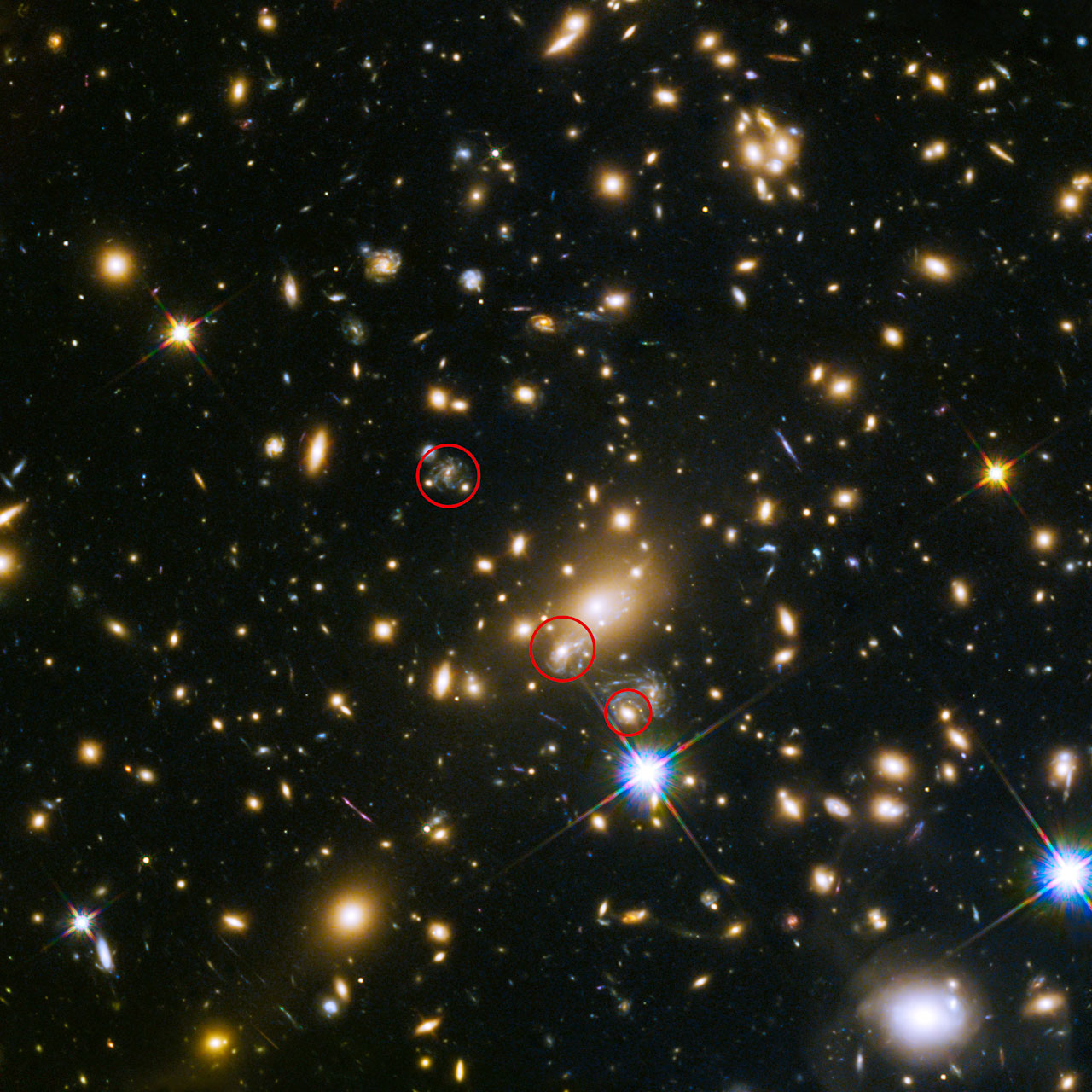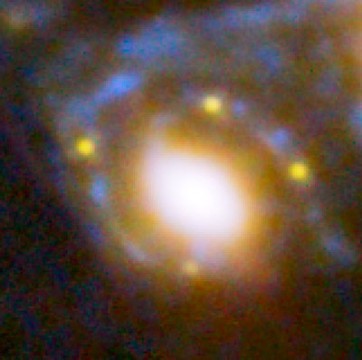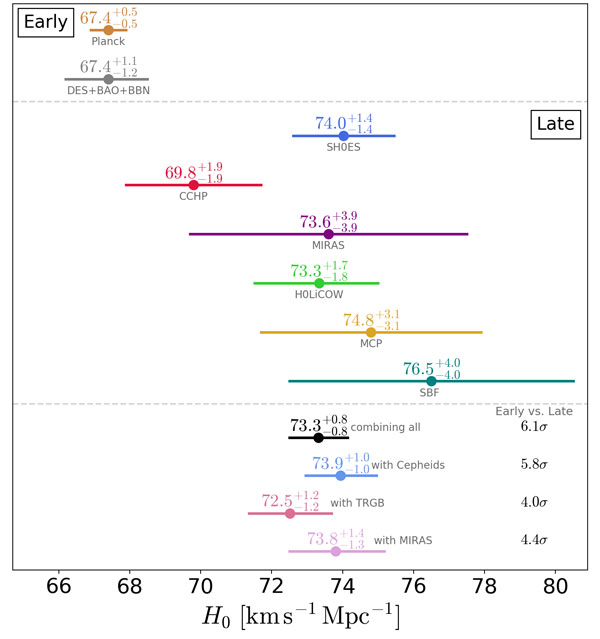A cosmic lens magnified the light of an exploding star. Now, astronomers are using observations of that supernova to calculate the universe’s current rate of expansion.

NASA / ESA / S. Rodney (JHUAPL) and the FrontierSN team / T. Treu (UCLA), P. Kelly (UC Berkeley) and the GLASS team / J. Lotz (STScI) and the Frontier Fields team / M. Postman (STScI) and the CLASH team / Z. Levay (STScI)
Stars explode all the time in the universe. But the supernova that Patrick Kelly found in 2014 marked serendipity at its finest: an explosion not only caught in the act of detonation but also magnified by the gravity of a confluence of foreground galaxies.
Now, Kelly (University of Minnesota) is leading a team in using this serendipitous supernova to get an independent measure of the universe’s current expansion rate — a quantity astronomers have been debating intensely for the last decade. Although the new measurement won't settle that debate, it does provide an independent method that astronomers badly need.
A Predicted Supernova

NASA / ESA / S. Rodney & the FrontierSN team /T. Treu / P. Kelly & the GLASS team / J. Lotz & the Frontier Fields team / M. Postman & the CLASH team / Z. Levay
Supernova Refsdal, named after Norwegian astronomer Sjur Refsdal, just so happened to go off under a cosmic lens from Earth’s point of view: A massive galaxy cluster magnified the supernova’s light and bent it, splitting it into separate but identical images. Kelly, who as a graduate student in 2014 was searching the Hubble Space Telescope images by eye, spotted three bright images and contacted his team right away. (A fainter fourth image was found later.) “It was immediately clear that it was very exciting,” he said in an interview at the time.
But the physics of gravitational lensing, which is the same as for the lenses in eyeglasses, should have created not four but five images. One image was missing. Kelly and his colleagues predicted that the light of the final image might be traveling a longer path to Earth through the cluster than that of the others and, depending on the path traveled, would appear in anywhere from a year to a decade.
A year later, it showed up.
Can a Supernova Break the Hubble Tension?
The new study, published in Science, explores what Supernova Refsdal can tell us about cosmic expansion. The universe has been expanding since the Big Bang, although at different rates. Astronomers have measured the rate at which the universe is currently expanding, called the Hubble constant, in many different ways. These ways often rely on carefully calculated distances. But as the measurements have become more precise, the answers have split between two numbers, creating tension.
While this tension is regarded as a potential problem for the standard model of cosmology (which includes mysterious dark matter and equally mysterious dark energy), there’s still the possibility that the different answers come about due to systematic errors in the measurements themselves. Supernova Refsdal offers a new way to estimate the Hubble constant that, while not free from systematic errors, is at least free from the ones that plague other estimates.
To calculate the Hubble constant, Kelly and his colleagues first needed to determine the distance to the supernova based on the last image’s delayed arrival. (The time delay itself is more precisely estimated in an accompanying paper, published in the Astrophysical Journal.) To do that, they first need to properly account for the distribution of mass in the intervening galaxy cluster. Since the cluster’s gravity is what’s bending the light, understanding its mass distribution is basically like knowing the prescription of the cosmic lens. Using a set of cluster models, Kelly’s team arrives at an estimate of the Hubble constant that’s between 63.3 and 70.7 km/s/megaparsec.

Vivien Bonvin / HOLiCOW Team
There’s a lot of wiggle room in that answer, but it’s in line with what astronomers have previously found by analyzing observations of the cosmic microwave background taken with the Planck satellite. And it’s below the other set of estimates, such as that from the SH0ES collaboration, based on observations of Cepheid variable stars and Type Ia supernovae, as well as from the H0LICOW team that studies distant, lensed quasars.
Christopher Kochanek (Ohio State University), who wasn’t involved in the study, says that it’s a solid result. But he questions whether the new measure of the Hubble constant is precise enough yet to be useful. The measurement’s uncertainty is 6%, and “you need a 1 or 2% measurement to be competitive,” he says.
“The devil is in the lens models,” he adds. Kelly’s team applied many models and then calculated a sort of weighted average of the results. But Kochanek explains that the gain in accuracy comes with an increase in uncertainty.
“Their uncertainty is mostly dominated by the spread between the models rather than the measurement of the actual time delay; unfortunately, this is exactly the kind of uncertainty which does not diminish by making more measurements,” he says. “You have to find some way of determining which lens model is 'right' (although there is no guarantee that any of them are).”
Kelly’s team agrees that the lens models are indeed the sticking point when it comes to precision, noting that if the cluster’s mass distribution were known exactly, they’d be able to measure the Hubble constant to within 1.5%. With improved models for the cluster’s mass based on JWST observations, more precise measurements may yet come from Supernova Refsdal.
Finding more lensed supernovae will be key to better understanding the Hubble constant. In fact, astronomers recently announced another lensed supernova in new JWST observations: SN H0PE. Certainly, the same method will also be applied to the myriad lensed supernovae that the upcoming Vera C. Rubin Observatory will find.
Editorial note (May 21, 2023): Additional information included on future work.
Editorial note (May 23, 2023): Clarified quote from Christopher Kochanek regarding the uncertainty in the Hubble constant measurement.
 1
1









Comments
Rod
May 21, 2023 at 7:28 am
Good report. I have been following reports on H0 obtained from Refsdal and other measurements too. Using the cosmology calculators for H0, bouncing from 63 to 71 km/s/Mpc or more, the universe age bounces too along with different sizes 🙂 The exoplanet sites show the confirmed exoplanet lists, someday I would like to see H0 values tracked like that too showing the various flavors 🙂
You must be logged in to post a comment.
You must be logged in to post a comment.